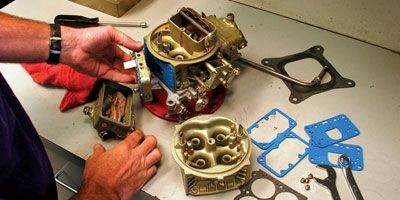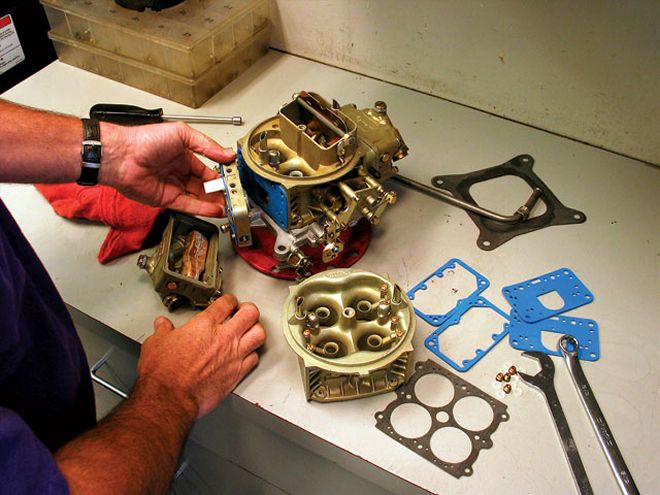
There are times when bigger is better. The original Holley carburetor has been around for a long time, and while it has benefited from improvements, there are certainly ways to make it better. A classic example is the 750 Holley mechanical-secondary carburetor (PN 0-4779). This veteran of the carburetor wars has long been the staple of more high-performance street engines than most other carburetors with perhaps the exception of its 750-cfm-vacuum-secondary cousin, the 0-3310.
 Swapping the HP body onto a standard 750 double-pumper Holley turned out to be quick, easy, and worth some power.
Swapping the HP body onto a standard 750 double-pumper Holley turned out to be quick, easy, and worth some power.
Several years ago Holley introduced the HP series of carburetors that featured no choke housing, a radiused entry into the main body, and screw-in idle and high-speed air bleeds among its many improvements. Rated at a similar 750 cfm, these are highly coveted carburetors but also somewhat pricey. To remedy this situation, Holley now offers the HP main body as a separate, bolt-in conversion. At just over $125, this is much cheaper than buying a brand-new HP carburetor of the same cfm rating, and you get most of the benefits of the better main body. For those of you looking for a great deal, find a less desirable PN 0-4777 650-cfm or PN 0-4778 700-cfm carb and apply this same HP conversion to pump up either of those carbs to 750 cfm. Both of these smaller carbs use the same 11116-inch-diameter throttle plates as the 750 carb, making this swap an inexpensive way to increase a smaller carb up to 750-cfm flow potential.
The full-on HP carburetors also offer stainless steel throttle plates, high-flow metering blocks, and Dominator-style float bowls that are not part of the HP body conversion, but you do get the advantage of the HP main body's screw-in idle and high-speed air bleeds should you wish to experiment with fine-tuning those circuits.
We decided to put this idea to the test by converting a typical 0-4779 Holley over to the HP to see what would happen. The results were certainly positive with a surprising average torque increase of 12 lb-ft and an average horsepower gain of 10. It doesn't get much easier than that.
The Swap
The conversion is simple enough. All you have to do is disassemble the carb and replace the main body. The HP body is boxed with the accelerator-pump squirters already in place along with larger 72 primary and 84 secondary jets to improve the air/fuel ratio based on the increased airflow promised by the HP's contoured inlet. We swapped the main body in about 10 minutes.
The Test
We figured the best way to test this was on our 466ci big-block Ford that we had on the dyno for our big-inch Ford story elsewhere in this issue using Jim Grubbs Motorsports' SuperFlow engine dyno. We have to admit that the 750-cfm carb was probably a bit small for this free-breathing Ford, so while this is still a good test, increasing the airflow potential through the carb with a cleaner main body would certainly deliver more of an advantage than you might see on an engine with less airflow and power potential. As an example, if we had used a 400hp 302 small-block Ford as our test mule, the difference in power between the two carb bodies would probably have been less.
With that said, we were impressed with the results we saw on our big-block Ford. A quick peak-to-peak horsepower evaluation revealed a minor 4hp difference--literally less than 1 percent. But once we compared the overall power curves, we saw major increases just past peak torque including a solid 14 lb-ft of torque at 4,600 and as much as 17 hp at 5,400 rpm. But the best news is the average power increase of 12 lb-ft and 10 hp across the entire test range.
To be fair to both carburetors, we did not use the air turbine to measure airflow since the particular unit JGM was using offers a slight restriction to airflow. Without the aid of cfm numbers, we looked more closely at the fuel flow and discovered that the power increases achieved by the HP conversion in the midrange could be attributed to roughly 5 percent less fuel than with the standard Holley carb. We had already increased jetting on the original 750 in order to improve power, yet the HP carb made more power with less fuel in the midrange. We'll attribute that to better mixture distribution in the engine from the HP's radiused inlet into the venturis of the carburetor. This may also have improved mixture distribution in the intake manifold as well. Either way, the HP made more power with measurably less fuel.
Test 1 was the baseline test on the Ford 460 with the PN 0-4779 750 carb, jetted to make best power. In Test 2, the only change was to the HP main body. The fatter jetting included with the HP carb was already in place so this effectively leaned out the air/fuel ratio on the HP conversion slightly.
TEST 1TEST 2DIFFRPM TQ HP TQ HP TQ HP3,800 534 386 546 395 12 94,000 540 411 550 419 10 84,{{{200}}} 544 435 555 444 11 94,400 538 451 549 460 11 94,600 523 458 537 470 14 124,800 518 473 528 482 10 95,000 503 479 520 495 17 165,200 492 488 508 503 16 155,400 472 485 489 502 17 175,600 468 499 468 499 0 0Avg. 513 456 525 466 12 10Peak 544 499 555 503 11 4Power/ci 1.16 1.07 Parts ListDESCRIPTION PN SOURCE PRICEHolley 750-cfm carb mech. 0-4779C Summitracing.com $397.88 Holley main body 134-300C Summitracing.com 125.39Holley 750 HP carburetor 0-80528-1 Summitracing.com 629.88Holley 650-cfm carb mech 0-4777C Summitracing.com 327.88Holley 700-cfm carb mech 0-4778C Summitracing.com 349.88